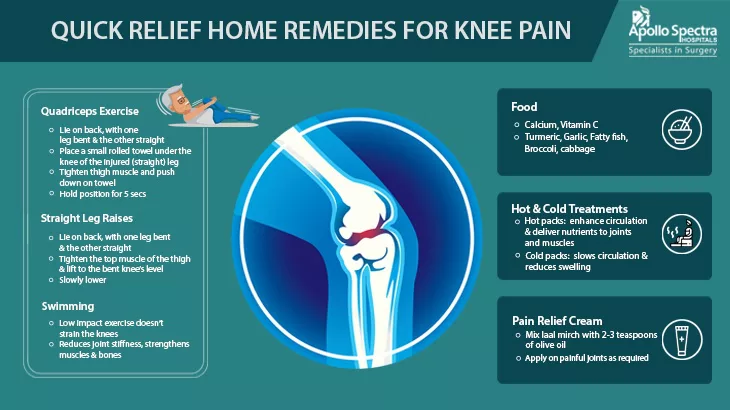Nine Home Remedies for Knee Arthritis
January 1, 1970

Dr Raj Kanna is an expert Knee Surgeon, trained in India and the United Kingdom with 17 years of experience in the field. He is a specialist in the Computer-Assisted Knee Replacement Surgery and Arthroscopic (Key-Hole) Surgery of the knee. He is renowned for his latest solutions for various knee problems such as arthritis, ligament injuries, etc; with a world-class hi-tech facility. He presently consults at Apollo Spectra Hospitals, Chennai. Here, he shares the best home remedies that you can follow for effective control of knee arthritis pain. Knee arthritis is a condition where cartilage in the knee breaks down, leading to inflammation, pain, and swelling in the knee joint. Usually, in healthy knees, the presence of cartilage allows the joint bones and the kneecap to glide smoothly during the joint’s movements. While the treatment for knee arthritis includes medicines which strengthen the cartilage and other treatment modalities, there are a variety of home remedies which are less expensive and can be followed easily by patients.
Nine Home Remedies for Knee Arthritis
The following home remedies not only reduce your knee pain, they can also improve joint function significantly.
- 1) Quadriceps Exercise
This exercise helps to strengthen the quadriceps muscle (the muscle on the front of your thighs), an important stabilizer of the knee. How to do it?
- Lie on your back with the leg you want to exercise with, straight
- Place a small rolled towel under the knee
- Slowly tighten the muscle on top of the thigh (quadriceps) and push the back of the knee down into the rolled towel
- Hold this position for 5 seconds and release slowly, resting 5 seconds between each contraction
- Perform 10 repetitions, 3 times daily
- 2) Straight Leg Raise
This exercise also helps in strengthening the quadriceps muscle. Follow these instructions:
- Lie down on your back and keep the leg you want to exercise with, straight
- Bend the other knee to support your lower back
- Tighten the muscle on the top of your thigh and lift to the level of your bent knee.
- Slowly lower.
- Perform this repetition for 10 rounds, 3 times daily.
- 3) Swimming
Swimming offers a low-impact workout if you have bad knees. Unlike heavy sports that place stress on your knees (as your feet hit the ground/floor’s hard surface), swimming allows you to move through the water without placing much pressure on the knee. Most people can exercise longer in water without strenuous effort or joint pain. Swimming can reduce your joint stiffness, strengthen muscles around your joints, strengthen your bones and improve your overall fitness.
- 4) Weight reduction
For every 1 kg of weight you lose, you reduce your knee joint’s load by 4 kgs! It’s important to maintain a healthy weight to ease up some of the stress on the joints.
- 5) Food for arthritis
Fruits, veggies and whole grains are natural inflammation fighters that can also help control your weight. Research suggests that following a healthy diet and adding in specific foods and spices could help fight inflammation and joint pain. Try to include the following in your diet:
- Broccoli and cabbage- These veggies help in slowing the cartilage damage in joints
- Fatty fish-Fatty fish like salmon, tuna, trout, and mackerel are rich in omega-3 fatty acids, which help fight inflammation. If you’re not a big fan of fish, you can take an omega-3 supplement.
- Garlic- Garlic is a member of the allium family—which also includes onions and leeks. These items help with a number of diseases—including arthritis.
- Turmeric-Turmeric contains a compound called curcumin which wards off inflammatory diseases.
- Vitamin C- Antioxidants in vitamin C may slow the progression of arthritis. You can get Vitamin C from strawberries, kiwi, pineapple and citric fruits.
- 6) Using Heat & Cold for Pain Relief
Heat treatments, such as heating pads or warm baths, tend to work best for soothing stiff joints and tired muscles. Heat enhances circulation, delivering nutrients to joints and muscles. Cold is the best for acute pain; it restricts blood vessels, slows circulation and reduces swelling. It also numbs nerve endings, dulling pain. Experiment with some of the following forms of heat and cold therapy to find out which provides the best pain relief for you.
Heat treatments for Knee Arthritis
- Take a warm shower or bath to ease morning stiffness.
- Try using a warm paraffin wax treatment system, available at many medical stones or beauty-supply stores.
- Use a heating pad (protect skin with a cloth buffer) for up to 20 minutes at a time. Or buy an air-activated heat pack if you need one that’s portable.
- Buy moist heat pads from the drugstore, or make one by putting a wet washcloth in a freezer bag and heating it in a microwave. Wrap the hot pack in a towel and place it over the affected area for 15 to 20 minutes.
Cold treatments for Knee Arthritis
- Wrap a bag of ice or bag of frozen vegetables in a towel to protect the skin, and apply to painful areas for no more than 20 minutes at a time.
- Try a store-bought gel cold pack; it won’t leak, tends to stay cold for longer, and comes in a sleeve-form that helps in the easy wrapping of the joint.
- Make your own pain relief cream
Mix laal mirch or ground cayenne pepper with 2-3 teaspoons of olive oil. Apply it on the skin of painful joints, several times a day. Make sure that this does not touch broken, cut, wounded or healing skin. The first few doses may cause a mild burning sensation, but eventually, the joint skin will become desensitized, after a week or so.
- Consume more calcium
Getting too little calcium raises the risk of osteoporosis, a brittle-bone condition that accelerates if you have rheumatoid arthritis. All women should get about 1,200 milligrams of calcium in a day, after the age of 50. Dairy is the most famous source of calcium, but it can also be found in vegetables such as cauliflower, cabbage, kale, broccoli, and turnip greens. Although these foods have lesser calcium compared to dairy products, they contain it in a form that is easier for the body to absorb.
- Knee Braces for Arthritis Pain
Knee braces provide a non-invasive option for reducing pain and getting you back to the activities you love.
There are different types of knee braces for arthritis pain:
- Basic knee sleeves: Knee sleeves are recommended for patients with mild pain that worsens with activity. They’re affordable, easy to wear, and easy to clean. They provide support while also reducing pain and swelling. Their compression can also help keep your knee joint warm.
- Advanced braces and compression sleeves: These are typically more customizable and are used by people who experience mild pain while exercising.
- Unloader braces for severe cases: These are advanced support braces, and reduce the weight going through the knee. This happens by changing the angle of the knee joint, and thus reducing the pain.
It is best to always consult an Orthopaedic surgeon before practising any exercise, routine or a major lifestyle change. Most of these home remedies have been suggested as a temporary relief for knee ailments for arthritis patients with mild to moderate pain. If you are suffering from severe knee pain, consult our experts here.
NOTICE BOARD
CONTACT US
CONTACT US
 Book Appointment
Book Appointment


.svg)
.svg)
.svg)
.svg)








